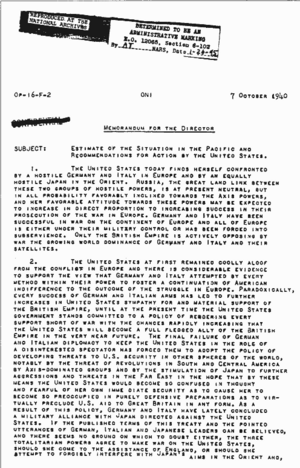McCollum memo facts for kids
The McCollum memo, also known as the Eight Action Memo, was an important document from October 7, 1940. This was more than a year before the attack on Pearl Harbor. It was written by Lieutenant Commander Arthur H. McCollum. He worked for the Office of Naval Intelligence, which is like the Navy's spy agency. McCollum was in charge of information about East Asia. He sent the memo to two Navy Captains, Dudley Knox and Walter Stratton Anderson.
The memo talked about the situation of different countries during World War II. It suggested eight steps the United States could take regarding Japan in the South Pacific. The memo even suggested that the U.S. should try to make Japan start a war. It said that the U.S. government probably couldn't declare war on Japan without a good reason. But if Japan could be made to attack first, that would be better.
The McCollum memo became widely known when Robert Stinnett published his book Day of Deceit: The Truth About FDR and Pearl Harbor. Stinnett claimed the memo was a plan to get America to join the war against Germany. He believed it was meant to make Japan attack American forces in Hawaii. This would bring the U.S. into the war without breaking promises to the public. However, McCollum himself said this was not true.
What Was the Eight-Action Plan?
The McCollum memo included an eight-part plan. This plan was designed to deal with Japan's growing power in East Asia. The memo started by saying:
"It is not believed that in the present state of political opinion the United States government is capable of declaring war against Japan without more ado; and it is barely possible that vigorous action on our part might lead the Japanese to modify their attitude. Therefore the following course of action is suggested:"
This means the U.S. government couldn't easily declare war on Japan. But strong actions might make Japan change its mind. So, the memo suggested these steps:
- A. Work with Britain: Make a deal with Britain to use their naval bases in the Pacific. Singapore was especially important.
- B. Work with the Netherlands: Make a deal with the Netherlands to use their bases and get supplies in the Dutch East Indies.
- C. Help China: Give all possible help to the Chinese government led by Chiang Kai-shek.
- D. Send Cruisers: Send a group of long-range heavy cruisers to the Pacific. They would go to places like the Philippines or Singapore.
- E. Send Submarines: Send two groups of submarines to the Pacific.
- F. Keep Fleet in Hawaii: Keep the main U.S. Navy fleet in the Pacific near the Hawaiian Islands.
- G. Support the Dutch: Insist that the Dutch refuse Japan's demands for too many economic deals, especially for oil.
- H. Stop Trade with Japan: Completely stop all U.S. trade with Japan. This would be done along with Britain.
The memo ended by saying: "If by these means Japan could be led to commit an overt act of war, so much the better. At all events we must be fully prepared to accept the threat of war." This meant that if these actions made Japan attack first, that would be good. Either way, the U.S. had to be ready for war.


